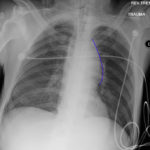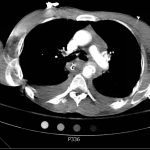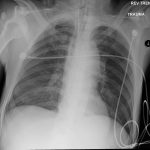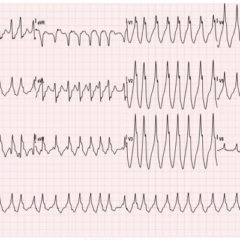Traumatic Aortic Injury
History of present illness:
A 48-year-old male with unknown past medical history presents as a trauma after being hit by a car traveling approximately 25 miles per hour. On initial presentation, the patient is confused, combative, and not answering questions appropriately. The patient is hypotensive with a blood pressure of 68/40 and a heart rate of 50 beats per minute, with oxygen saturation at 96% on room air. FAST scan is positive for fluid in Morrison’s pouch, splenorenal space, and pericardial space.
Significant findings:
The initial chest x-ray showed an abnormal superior mediastinal contour (blue line), suggestive of a possible aortic injury. The CT angiogram showed extensive circumferential irregularity and outpouching of the distal aortic arch (red arrows) compatible with aortic transection. In addition, there was a circumferential intramural hematoma, which extended through the descending aorta to the proximal infrarenal abdominal aorta (green arrow). There was also an extensive surrounding mediastinal hematoma extending around the descending aorta and supraaortic branches (purple arrows).
Discussion:
Traumatic aortic injury is a life-threatening event. The incidence of blunt thoracic aortic injury is low, between 1 to 2 percent of those patients with blunt thoracic trauma.1 However, approximately 80% of patients with traumatic aortic injury die at the scene.2 Therefore it is imperative to diagnose traumatic aortic injury in a timely fashion. The diagnosis can be difficult due to the non-specific signs and symptoms and other distracting injuries. Clinical suspicion should be based on the mechanism of the injury and the hemodynamic status of the patient. In any patient with blunt or penetrating trauma to the chest that is hemodynamically unstable, traumatic aortic injury should be on the differential. Chest x-ray can be used as a screening tool. A normal chest x-ray has a negative predictive value of approximately 97%. CTA chest is the gold standard with a sensitivity and specificity approaching 100%.2
Topics:
Thoracic aortic injury, chest, trauma, vascular, aorta.
References:
- Ungar TC, Wolf SJ, Haukoos JS, Dyer DS, Moore EE. Derivation of a clinical decision rule to exclude thoracic aortic imaging in patients with blunt chest trauma after motor vehicle collisions. J Trauma. 2006;61:115001155. doi: 10.1097/01.ta.0000239357.68782.30
- Creasy JD, Chiles C, Routh WD, Dyer RB. Overview of traumatic injury of the thoracic aorta. Radiographics. 1997;17(1):27-45. doi: 10.1148/radiographics.17.1.9017797
- O’Conor CE. Diagnosing traumatic rupture of the thoracic aorta in the emergency department. Emerg Med J. 2004;21(4):414-419. doi: 10.1136/emj.2002.001834
















